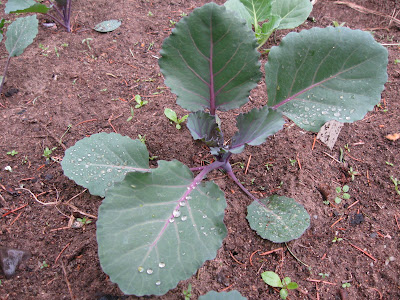
Thanks to issues with cabbage root maggots the planting of certain brassicas, mainly cabbage, broccoli, brussels, cauliflower, and kohlrabi can be quite a chore in our gardens. The adult, similar in appearance to that of small housefly, lays eggs in the soil next to the stems of cole crops. When the larvae hatch they make their way down to the roots and eat tunnels throughout the root system causing the plants to eventually fail.
"One of the solutions to this problem, and the one that works best for us, is to cut squares of perforated weed barrier and place them around the base of each and every plant" he says with an exhausted sigh. Floating row covers can also keep the flies off cole crops but wind and water issues prevent us from using them. Besides, what fun would simple row covers be when one can look forward to cutting and placing hundreds of little squares instead. :)
First we separate, in this case ruby perfection cabbage plants from the tangled web they have weaved in my flats. Yeah, I planted them a little too close together and this is why I'm planting this particular batch out now rather then waiting until they are bigger as I normally do. We used really old seed and did not expect such good germination.
 We plant them as deep as possible, even covering the first little set of leaves with soil. Planting this deep enables the cabbage, with its shallow root system the ability to access more soil moisture. Also this helps to keep it from flailing about in the wind... an issue we have, especially in the early spring. We actually have to put wooden stakes on the east side of full size cole crops to keep occasional wind gusts from literally ripping them out of the ground.
We plant them as deep as possible, even covering the first little set of leaves with soil. Planting this deep enables the cabbage, with its shallow root system the ability to access more soil moisture. Also this helps to keep it from flailing about in the wind... an issue we have, especially in the early spring. We actually have to put wooden stakes on the east side of full size cole crops to keep occasional wind gusts from literally ripping them out of the ground. Then I put a small (6x6") square of weed barrier, with a slit cut half way down the middle, around the base of the plant making sure to leave a slight bowl shaped depression so that water will more easily penetrate through to the roots of the cabbage.
Then I put a small (6x6") square of weed barrier, with a slit cut half way down the middle, around the base of the plant making sure to leave a slight bowl shaped depression so that water will more easily penetrate through to the roots of the cabbage.
 Cover with dirt and I'm ready to move on to the next one. In the past we also added a little wood ash around the plant as this seems to work as a repellent as well.
Cover with dirt and I'm ready to move on to the next one. In the past we also added a little wood ash around the plant as this seems to work as a repellent as well. I'm planting my cabbages in three different stages this year, hoping to come up with the perfect heads for winter storage. As much as I love cabbage it is certainly not one of the easiest crops for me to grow due to weather, insects, and my general lack of a green thumb. Perhaps this will be the year I finally master this most simple of all vegetables to grow.
I'm planting my cabbages in three different stages this year, hoping to come up with the perfect heads for winter storage. As much as I love cabbage it is certainly not one of the easiest crops for me to grow due to weather, insects, and my general lack of a green thumb. Perhaps this will be the year I finally master this most simple of all vegetables to grow."Cabbage: A vegetable about as large and wise as a man's head." - Ambrose Bierce, American writer (1842-1914)
General disclaimer:
This post is in no way meant to diminish the worthiness of a root maggot or any of their kind. I am aware that we all have a right to live full and productive lives to the best of our abilites. Some species tunnel through cabbage roots while other species place numerous little squares to prevent tunneling.
Stupid maggots.























10 comments:
Ha! Very clever! I will have to give this a try. Lovely blog by the way.
Ohboy Mike you always leave me amazed by your perseverance. Doing the collars on my peppers and tomatillos recently nearly did me in! I've only had that maggot damage once and only lost 2 plants...but hoo boy, you will be BUSY for a while with those things won't you? I am quite jealous of your lovely soil though.
Oh my - I never thought that a post about maggots could be that entertaining! You had me laughing out loud by the end (as well as Daniel to whom I read the last few sentences). Although you are probably not quite so amused having to protect every little plant...;) Silke
Hello Anonymous,
The little weed barrier squares work really well, we almost never have any cabbage maggot damage anymore. I left three brussel sprouts with out sheets last year just to see if I still needed to use them and sure enough two of them died.
Thanks for stopping by, and for the nice comment.
Mike
Hi El,
I'm not sure if it is perseverence or insanity, sometimes I wonder if it is worth all the hassel... of course all I have to do is look around at the local grocers wares to realize that it is.
I'm so glad that I never have any problems with pests on my peppers and tomatillos. It's one thing to lose a cabbage, but a tomatillo or hard earned pepper... perish the thought. Yes I will be very busy, the brassicas are almost finished and I am desperately trying to figure out where in the world I am going to plant my beans next week.
We are so fortunate to have really great soil, it is one thing that is definitely in our favor.
Have a great day, or evening... jeez it's already after 8:00.
Mike
Silke,
It's hard to make such a morbid, and boring subject as root maggots entertaining but I do try. I'm glad it made you laugh.
In all honesty, I used to get quit upset when things like insects , weather, or whatever tried my gardening patience. Now I smile and tell myself that the little things, they really don't matter that much... not in the whole scope of life anyway. It really makes it much easier to deal with.
Keep smiling,
Mike
Oh, Mr. H., I wonder if that might work for my personal nemesis, leaf miners. Chard, spinach (a complete favorite) and beets are almost impossible to grow for me.
Little tiny squares might make it happen. Thanks for the idea!
Hi Stefaneener,
We also fight of leafminers every summer, they seem to arrive around mid July in our area. The "little squares" Might help with leafminers, I have never tried using them with chard and beets.
I know that some species of leafminers pupate in the soil but it seems that the ones we get on our greens lay eggs on the underside of the leaves. floating row covers might work well for this issue.
We find that immediately pulling any mined leaves, and in our case feeding them to the chickens works best for us. I also try to find the little egg clusters under the leaves before they hatch. Keep in mind that this little stinker goes through several generations every year so one has to be most diligent with control.
I will try to do a post about them this summer when they start infecting my Swiss chard leaves. The last two years they have been pretty bad in our area, perhaps we will be lucky this summer. :)
Hey Mike!
Thanks a heap...every time I read one of your informative posts something is added to my chore list.
Oddly enough the one veg I did not do this year was cabbage due mainly to slugs and disinterested roomates, (is there a difference?).
Anyhoo, I'm still reading you and learning something each time I do so please carry on for the sake of all we would be Northern gardeners.
your eternally grateful pal, Randi
Hi Randi,
Believe me I understand "all" your issues with slugs. I'm glad you are interested in the blog. The whole reason I started it was to have someone in the world that was like minded to communicate with. Other than the people on these forums I know of absolutely no one who shares the same interests as us.
Thank you for reading my posts, and remember that you don't have to accomplish everything... there is always next year.
Mike
Post a Comment